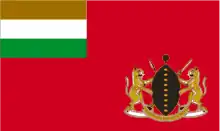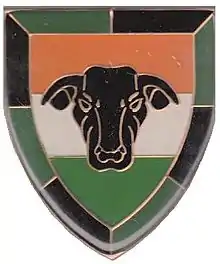| Transkei Defence Force | |
|---|---|
 Flag of the TDF | |
| Founded | 1981 |
| Disbanded | April 1994 |
| Service branches | Infantry Special Forces Air Wing |
| Headquarters | Umtata |
| Leadership | |
| Commander-in-Chief | Major General Bantu Holomisa |
| Personnel | |
| Military age | 18–49 |
| Related articles | |
| History | Military history of South Africa |
| Ranks | Military ranks of Transkei |
The Transkei Defence Force (TDF) was established during March 1981, from the 141 Battalion of the South African Defence Force (SADF). It was the defence force of the Republic of Transkei, a nominally independent bantustan during the Apartheid era of South Africa.
History

Origin
In 1981, the newly formed Transkei Defence Force (TDF) received a gift of equipment from the South African Defence Force.
The Rhodesian connection
In 1982, the Minister of Defence and then Prime Minister, G.M. Matazima announced the employment of a group of expatriate advisers from the former Rhodesia. A group of about 30 former Rhodesians had actually commenced employment in March 1981, under the auspices of the Security Services Transkei Company. Former Rhodesian Selous Scouts founder Ronald Reid-Daly was hired to serve as commander of the TDF and to supervise training.[1]
Head of the Defence Force
President K.D. Matanzima retired as State President in February 1986, and was succeeded by his brother, G.M. Matanzima.
Attack on the Ciskei
In 1985, Apartheid practitioners conceived a plan to merge the Transkei and Ciskei and create a 'united nation of Xhosa speakers' who they thought would support the South African government and help it to stamp out unrest in the Eastern Cape. Matanzima had long held ambitions to rule such a territory, and had opposed the 'independence' of Ciskei in 1981 in the hope that this merger would be realised.
On 19 February 1987, a truckload of Transkei special forces entered the Ciskeian capital Bisho, and unsuccessfully attacked the home of the Ciskei President, Chief Lennox Sebe. The raid was apparently under the control of the former members of the Rhodesian Security Forces, although Matanzima refused to admit Transkeian involvement. The raid appeared to be aimed at the overthrow of Lennox Sebe, but the plan failed, after it was leaked to Brigadier Bantu Holomisa.[2]
Consequences of the attack
This together with resistance to the raid from elements within the Transkei, played an important role in the ascendance to power of Stella Sigcau and Brigadier Bantu Holomisa.
By April 1987, the contracts of 27 white military officers, including the former Rhodesians, were terminated and a group of 20 of these men including their commander, Major General Ronald Reid-Daly were expelled from the Transkei.
Rumours of a coup attempt by the former State President K.D. Matanzima followed the expulsions. The botched raid also earned Transkei the enmity of South Africa which had considered the Rhodesians to be a stabilising factor.
President G.M Matanzima announced Brigadier Holomisa who had been released due to public pressure after nine weeks detention would be promoted to major general and would succeed General Zondwa Mtirara as commander of the TDF. Holomisa had been detained by the Government as he had apparently agitated against the role of the white officers in the TDF as well as stirring disaffection on the basis of the Matanzima government.
Coup
By 23 September 1987, TDF soldiers served resignation letters on the Transkei cabinet. President G.M. Matanzima resigned in the wake of mounting evidence of corruption. Ms Stella Sigcau was elected as the new Prime Minister, but the TDF took over the administration of the Transkei in a bloodless coup on 30 December 1987, after only 86 days. Major General Holomisa declared martial law and suspended the Transkei constitution, alleging Ms. Sigcau had been involved in the corruption as well. A military council was formed and remained in power.[3]
Coup attempt
In November 1990, a group of six white and black soldiers attempted to mount a coup, but they failed when troops loyal to Holomisa overcame the plotters. Eighteen people were killed, including the leader of the coup, Colonel Craig Duli.[4]
Equipment
The TDF was equipped for counter-insurgency (COIN) operations. The TDF used:
- R4/R5 assault rifles,
- 7.62 mm (0.300 in) light machine guns,
- 40 mm (1.6 in) multiple grenade launchers,
- 60 mm (2.4 in) and 81 mm (3.2 in) mortars and
- 7.62 mm (0.300 in) Browning machine guns.
Insignia

Ranks
| Rank group | General / flag officers | Senior officers | Junior officers | Officer cadet | ||||||||||||||||||||||||||||||||
|---|---|---|---|---|---|---|---|---|---|---|---|---|---|---|---|---|---|---|---|---|---|---|---|---|---|---|---|---|---|---|---|---|---|---|---|---|
 |
 |
 |
 |
 |
 |
 |
 |
 |
 |
|||||||||||||||||||||||||||
| General | Lieutenant general | Major general | Brigadier | Colonel | Lieutenant colonel | Major | Captain | Lieutenant | Second lieutenant | |||||||||||||||||||||||||||
| Rank group | Senior NCOs | Junior NCOs | Enlisted | |||||||||||||||||||||||||||||||||
|---|---|---|---|---|---|---|---|---|---|---|---|---|---|---|---|---|---|---|---|---|---|---|---|---|---|---|---|---|---|---|---|---|---|---|---|---|
 |
No insignia | |||||||||||||||||||||||||||||||||||
| Chief warrant officer | Warrant officer | Staff sergeant | Sergeant | Corporal | Lance corporal | Private | ||||||||||||||||||||||||||||||
Awards
Cross for Bravery
Faithful Service Medal (10 Years)
.png.webp) Independence Medal
Independence Medal Military Rule Medal
Transkei Defence Force Medal
 Commander Class Medal (CCM)
Commander Class Medal (CCM)
Disbandment

With the end of Apartheid in 1994 in South Africa, the former defence forces of the Bantustans were incorporated into the newly formed South African National Defence Force.[7] The SANDF's new 14 South African Infantry Battalion heraldry clearly originates from the Transkei Defence Force, its forebear.
References
- ↑ "Lieutenant-Colonel Ron Reid-Daly". The Telegraph.
- ↑ tinashe (16 March 2011). "Transkei". sahistory.org.za. Retrieved 2 April 2018.
- ↑ "Army Stages Coup, Ousts Woman Prime Minister In Transkei". AP NEWS. 30 December 1987. Retrieved 30 November 2021.
- ↑ "Coup Attempted In Transkei Homeland". AP NEWS. 22 November 1990. Retrieved 30 November 2021.
- 1 2 "Transkeian Defence Force Badges of Rank". Retrieved 3 June 2021.
- 1 2 Cilliers, Jakkie (1993). "An Overview of the Armed Forces of the TBVC Countries". South African Defence Review (13). Archived from the original on 24 June 2016.
- ↑ Wood, Geoffrey; Mills, Greg (1992). "The present and future role of the Transkei defence force in a changing South Africa". Journal of Contemporary African Studies. 11 (2): 255–269. doi:10.1080/02589009208729541.